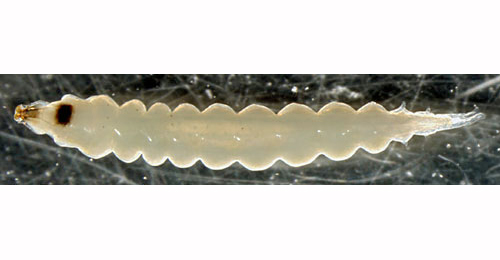|
||||||
|
Phyllocnistis
unipunctella (Stephens, 1834) Poplar Bent-wing Argyromiges
unipunctella
Stephens,
1834. Ill. Brit. Ent. Haust.
4: 260. |
||||||||||||||||||||||||||||||||||||||||||||||||||||||||||||||||||||||||||||||||||||||||||||||||||||||||||||||||||||
|
Leaf-miner: A 'snail-trail'-like mine on the upper surface, long and sinuous, without any visible frass. The mine can sometimes cover most of the leaf (British leafminers). Very long, broad, epidermal corridor that winds in dense loops over the upperside of the leaf without crossing itself. Frass in a continuous, extremely vague central line. The mine ends at the leaf margin, where the corridor is slightly widened, and in which some silk is deposited. When this dries the the leaf margin somewhat folds over this pupal chamber, since it is here that pupation takes place.The mine has a strong resemblance to the trail of dried mucus left by a small snail, which has given the mine its Dutch name of snail-trail mine (Bladmineerders van Europa). The mine is also illustrated in the Encyclopedia of Life. Larva: The larvae of moths have a head capsule and chewing mouthparts with opposable mandibles (see video of a gracillarid larva feeding), six thoracic legs and abdominal legs (see examples). The larva is illustrated in Bladmineerders van Europa.
Pupa: The pupae of moths have visible head appendages, wings and legs which lie in sheaths (see examples). The pupa is illustrated in Bladmineerders van Europa. Under a membrane on the margin of leaf (British leafminers). Adult: The adult is illustrated in UKMoths and the Encyclopedia of Life. The species is included in mothdissection.co.uk. Hosts in Great Britain and Ireland:
Hosts elsewhere:
Time of year - larvae: June, August (British leafminers). Time of year - adults: The adults fly in July and from September onwards, overwintering sometimes in haystacks (UKMoths). Distribution in Great Britain and Ireland: Fairly common in most of England, becoming scarcer further north (UKMoths) including Bedfordshire, Cambridgeshire, Cumberland, Denbighshire, Derbyshire, Dorset, East Cornwall, East Gloucestershire, East Norfolk, East Suffolk, Flintshire, Glamorgan, Hertfordshire, Huntingdonshire, Isle of Wight, Leicestershire, Mid-west Yorkshire, Middlesex, Montogoemryshire, North Hampshire, North Somerset, Shropshire, South-west Yorkshire, Stafford, West Cornwall, West Gloucestershire, West Lancashire, West Norfolk, West Suffolk and Westmorland (NBN Atlas). See also British leafminers distribution map. Distribution elsewhere: Widespread in continental Europe including Austria, Belgium, Bosnia and Herzegovina, Corsica, Czech Republic, Danish mainland, Estonia, Finland, French mainland, Germany, Greek mainland, Hungary, Italian mainland, Lithuania, Luxembourg, Norwegian mainland, Poland, Portuguese mainland, Romania, Russia Central, East, Northwest and South, Slovakia, Sweden, Switzerland, The Netherlands and Ukraine. Also recorded in Near East (Fauna Europaea). NBN Atlas links to known host species:
British and Irish Parasitoids in Britain and elsewhere:
|
||||||||||||||||||||||||||||||||||||||||||||||||||||||||||||||||||||||||||||||||||||||||||||||||||||||||||||||||||||
| Last updated 29-Jun-2019 Brian Pitkin | ||

